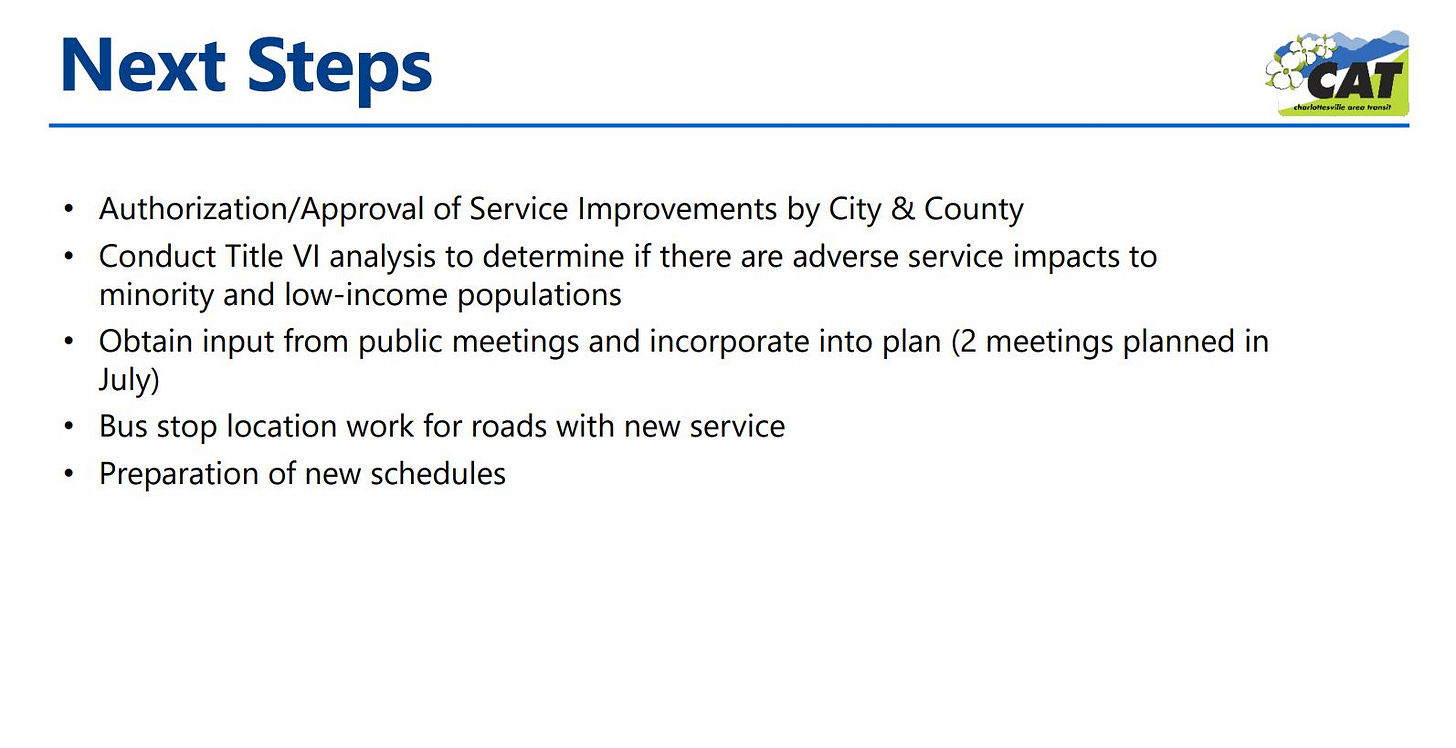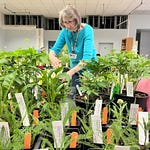With the summer heat in full swing, your local energy nonprofit, LEAP, wants you and yours to keep cool. LEAP offers FREE home weatherization to income- and age-qualifying residents. If you’re age 60 or older, or have an annual household income of less than $74,950, you may qualify for a free energy assessment and home energy improvements such as insulation and air sealing. Sign up today to lower your energy bills, increase comfort, and reduce energy waste at home!
On today’s show:
An uptick in COVID cases continues throughout Virginia
Council approves Fontaine Avenue streetscape design and extra funding for Meadow Creek Valley trail
Charlottesville Area Transit continues route change public input session while Albemarle gets ready for theirs
Today the seven-day average for new COVID-19 cases in Virginia is 671 and the seven-day percent positivity has increased to 4.3 percent. As of today, 53.6 percent of Virginians are fully vaccinated, and do keep in mind that this number includes people under the age of 12 who cannot yet receive a shot. From June 19 to July 18 this year, there have been 8,012 new cases of COVID in Virginia and 97.09 percent cases are in people not fully vaccinated. There have been 25 deaths, and all but two were in people not fully vaccinated.
Dr. Costi Sifri is the director of hospital epidemiology at the University of Virginia.
“I think we’re fortunate in Charlottesville and Albemarle and our surrounding communities because we have a relatively high vaccination rate and we are also in a state that is one of those minority of states that vaccine rates that are above 50 percent and that’s provided some barriers to widespread transmission of Delta,” Dr. Sifri said.
Dr. Sifri acknowledged the uptick in cases, but said other parts of the country are experiencing much steeper climbs.
The Thomas Jefferson Planning District Commission has been granted $2 million to spend on affordable housing projects. The funding comes from a statewide initiative from Virginia Housing called Resources Enabling Affordable Community Housing in Virginia, or REACH. Earlier this month, the agency announced it would spread $40 million around the state. Nonprofit groups, developers and others will be able to apply for the funding to help finance new construction.
“This funding puts the Central Virginia Regional Housing Partnership (CVRHP) and the TJPDC in a strong position to be able to contribute to affordable housing solutions through the development of new rental, homeowner, and/or mixed-use housing opportunities,” said Christine Jacobs, the interim director of the TJPDC.
The TJPDC has received funding for planning projects related to housing, but this is the first time the regional agency will play a role in the financing. Details to follow, and we’ll learn more at the TJPDC’s meeting on August 5.
Work on the replacement of the Belmont Bridge is picking up. Beginning today, flagging crews will periodically halt the flow of traffic while work is conducted to relocate utility lines.
“The contractor is undergrounding electrical as well as telecommunication lines to accommodate the future pedestrian underpass under 9th/Avon Street between South Street and Monticello Road,” reads a release sent out Friday afternoon.
More information about how construction will be conducted will be given out at an information meeting on August 11.
*
Today’s main segment consists on a lot of catch-up items from last week.
Charlottesville will seek additional funding to implement a plan to build a trail along Meadow Creek through the City of Charlottesville. Trails planner Chris Gensic told Council the details last week on a Transportation Alternatives grant opportunity offered by the Virginia Department of Transportation.
“The grant the parks department is pursuing is to construct a long awaited portion of an [Americans with Disabilities Act] accessible the Meadow Creek valley from the Michie Drive area up to the Virginia Institute of Autism at Greenbrier Drive and also around the corner to Greenbrier Park,” Gensic said.
The city will use $135,000 from an already-funded capital account for trails to match federal dollars that come through VDOT for a total of $675,000.
“That’s on top of about $375,000 we already have for this particular project,” Gensic said. “Costs have gone up over the years so we’ve determined we’re going to need this extra money for this particular project in Meadow Creek.”
Council approves Fontaine Avenue streetscape design
Council also approved the design for the $11.7 million Fontaine Avenue Streetscape, a project funded by VDOT’s Smart Scale in 2017 that is working through the long process from idea to construction. Kyle Kling is a transportation planning manager for the City of Charlottesville.
“In January of 2020, Council accepted the Planning Commission’s recommendation that this project’s conceptual design was found to be in accordance with the city’s Comprehensive Plan,” Kling said.
But what is the project, and what will it do for the half-mile stretch of Fontaine Avenue from city limits to where the roadway becomes Jefferson Park Avenue? Owen Peery is an engineer with design firm RK&K.
“In line with the City of Charlottesville’s overall transportation goals, the project seeks to make Fontaine Avenue a complete street which should produce accommodations for all users,” Peery said. “Ensuring safe passage for pedestrians and bicyclists, understanding that this serves as a gateway corridor into the city and ensuring the impression is attractive and improving access to local facilities and ensuring these facilities are easily accessed by pedestrians, bicyclist, and transit users.”
Final design will continue while property is acquired for public right of way, and construction would begin sometime in 2023.
Councilor Michael Payne had a question about something not in the plan.
“I’ve been reading through some of the community feedback and there are a couple of people who have raised the question of why these aren’t protected bike lanes with bollards or some kind of physical separation between the bike lane and the road where cars are,” Payne said.
Kling said the main reason is the need to keep the travel lanes accessible to emergency vehicles given the presence of the Fontaine fire station.
“We felt that if we were to put 11-foot travel lanes out there with some type of separated facility restricting access, it would make it more challenging for those vehicles to travel the corridor when needed,” Kling said.
The other reason is the presence of lots of driveways along the roadway, which would need to be closed.
Mayor Nikuyah Walker asked City Manager Chip Boyles to ask the University of Virginia to contribute financially if there are any cost overruns. Specifically, she suggested the city could ask to transfer some of UVA’s $5 million commitment for the fourth phase of West Main Street.
“There’s a lot of traffic in that area due to their work too that maybe that could be transferred,” Walker said. “I think its a conversation that is worth having,” Walker said.

Limited options to assist Greyhound
At the very end of the meeting, City Councilor Heather Hill asked if the city would be playing any role in the plight of Greyhound, which has closed its station on West Main Street but still picks up passengers on the street.
“I just want to acknowledge to the public that we’re hearing the frustrations,” Hill said. “The most recent comment that came today was around the role our own bus station could play as a housing location for those stops.”
City Manager Chip Boyles said he is concerned about the situation.
“A lot of our citizens utilize Greyhound to travel,” Boyles said. “We are very limited in what we can do because it is a private carrier and a private service.”
Boyles said the city has been asked to provide a shelter, but they can’t do so on private property without a landowners’ permission. Still, he is trying to work out a solution.
“We would love to talk with Greyhound,” Boyles said. “I know that they have inquired. The last that we heard was that they were just looking for someone to take over the service.”
For many years, the city helped subsidize Greyhound but stopped the practice beginning with the FY2014 budget.
Two other intercity bus services travel through Charlottesville, though both go north to rather than southeast to Richmond. These are the Piedmont Express run by the Virginia Department of Rail and Public Transportation, and Megabus. Both of those services utilize a stop at Arlington Boulevard and Barracks Road.
Charlottesville completes transit public input sessions
Keeping on the transit theme, last week Charlottesville Area Transit held the second of two public input sessions on upcoming route changes. The presentation on July 21 was the same as five days earlier. This time the first question came from Jane Colony Mills, the executive of the food pantry Loaves and Fishes.
“We are located down Lambs Road at the intersection of Hydraulic and Lambs,” said Mills. “We serve probably 25 to 30 percent of Charlottesville’s population but if you don’t have a vehicle they can’t get to us.”
The nearest bus line is Route 5, and it’s about three quarters of a mile away from the nearest stop on Commonwealth Drive.
“I was out doing registration today and there are just numerous people who have to catch rides or figure out other ways of accessing our services because they can’t get here on public transport,” Colony Mills said.
Another person on the call wanted to know if service could be restored to Albemarle Square, which has a new tenant in a new grocery store. CAT Deputy Director Juwhan Lee explained why there are no bus routes there anymore.
“The property owner actually asked us to leave the property and so until they invite us back in, we will not able to serve the property directly,” Lee said.
The route changes will have to be approved by Council before going into effect.
At the same time, Albemarle County and the Thomas Jefferson Planning District Commission begin the public input component of the a study about ways to expand transit in urban Albemarle, with the goal of increasing service to Route 29 north of the Rivanna River, to Pantops, and to Monticello. Tonight’s meeting deals with service in the north and begins at 6 p.m. (meeting info)


















Share this post